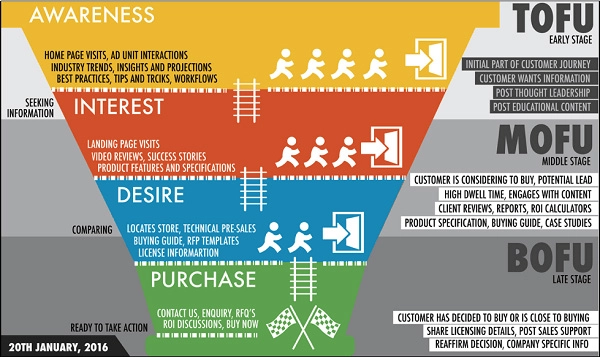
Introduction
Generating leads is a priority for every B2B company – whether big or small. While it is relatively easy to get leads, generating marketing qualified leads that are likely to convert, is not as simple as it sounds. To do so, marketers have to spend more time researching and developing a more complex funnel to get such leads.
MQLs are prospects who are likely to become sales leads, and eventually convert into customers. They are prospects who have been primed through different methods. In most instances, MQLs take specific actions that show their interest in your offerings based on your lead scoring strategy.
The criteria for qualifying these leads tends to vary from one company to another, but generally includes tracking actions such as:
- Reading blog content
- spending time on your website
- Requesting product demos
- Registering for webinars or online courses
- Downloading content like white papers, ebooks, case studies or guides
- Placing items in shopping carts
- Signing up for email newsletters
At this point, MQLs are not ready to engage a sales rep. However, they have already taken the initial steps of their customer journey. They know about your business, are curious about your offerings and are beginning to realize that the solutions you offer might address their problems.
After identifying MQLs, B2B marketers should nurture them to build trust in their brand and get them to accept the solutions they offer. The main strategy that companies use to nurture MQLs is content marketing. By nurturing MQLs and not letting them go, marketers make it easier for sales teams to convert them into customers.
HubSpot VP of Operations observes that, “If you only serve up the MQLs, then Sales spends less time searching for those MQLs in their typical process, and more time selling to the golden nuggets you supply, thus closing more deals.”
But nurturing MQLs is not a one-off, short term activity – the process of converting these leads into customers can be a long and tedious one. As a matter of fact, 95% of MQLs go to your website to research, they’re not ready to engage a sales rep yet. Ultimately, 70% of these leads will ultimately make a purchase – which is why you should not ignore MQLs that aren’t ready to buy yet. Most marketers are aware of this fact – close to 70% of them agree that on average, it takes three to six months to close deals with MQLs, according to a Frost & Sullivan study.

So, why should B2B marketers hang on to MQLs and not let go even when months pass before they convert? Below, we explore top 4 reasons why MQLs will eventually convert if you do your marketing right.
1. You Have An Idea What Your Leads Want
While MQLs are on the top of the funnel, they are prospects who have already taken actions that show interest in your offerings. They could have visited your website and downloaded content, signed up for email newsletters or webinar, or even contacted you with a request for information or product demo. Whatever the case, MQL actions give you an idea of what they are interested in or the solution they intend to purchase.
They not only imply interest, but they are also reflective of MQL’s awareness of your solutions and the fact that they are considering your offerings. Some MQL indicators that give you an idea of what these leads might be looking for include:
- Signing up for a software demo or free trial
- Completing and online form
- Downloading a pricing guide
- Requesting you for additional information about your offerings
- Adding a product to their shopping cart
- Liking a product or service on social media
This information enables you to run a more targeted lead nurturing campaign that increases their chances to convert.
2. You Already Have the Contacts Of MQLs
If you use lead capture forms to capture leads, you’ll end up with a list of names, contact information and even job titles of your MQLs. With this information, you can run campaigns to nurture those leads until they are ready to buy. One of the most effective ways to do this is through email campaigns.
Here are some tips to enable you run an effective email campaign:
- Segment your MQLs: Your leads are not the same – they’ll vary based on company size, gender, age, job title, location, preferences, and where they are on the buyer’s journey. Running a single nurturing campaign for all prospects might affect your lead nurturing efforts negatively. By segmenting the leads, you’re able to send them exactly what they need without spending too much time crafting emails for each lead.
- Automate your email campaigns: After segmenting your leads, leverage automation to enhance your email marketing Automating your campaigns reduces your chances of missing out on prospects. It also enables you to schedule emails to ensure that your leads receive and view them at opportune times. But these aren’t the only things marketing automation allows you to do – you can also monitor customer behavior with the software. This enables you to keep tabs on email open rates, click-through rates and prospect actions when they get to your site.
- Personalize your emails: Automation and segmentation works well when you deliver personalized marketing emails to your leads. You can do this easily through the use of dynamic content where you create a single email then customize different pieces based on the people who will receive the email. For instance, if you are creating emails for a travel firm, maintain the same body, but edit the banner image based on where your leads are located.
- Customize your customer’s purchase journey: To nurture your leads well, automate your customer journeys. The easiest way to do this is to define the triggers that your prospects perform and use them to send automatic emails to them based on their behavior or actions.
- Include a strong call-to-action: When creating emails, ensure that you end them with a compelling call-to-action to convert MQLs.
Besides running email campaigns, use varying touchpoints to nurture your leads. A report by Aberdeen shows that on average, a B2B sale can take over ten touch points to close. To keep prospects interested, vary your touch points while ensuring that they are relevant to your lead’s buying cycle. Some great touch points to include in your nurturing campaigns include:
- Blog posts
- Whitepapers
- Calculators
- Social media competitions
- eBooks
- Games
3. You Can Track MQL Behavior Along The Buyer Journey
When you look at the buyer’s journey, you’ll find that MQLs will be at the consideration stage. They already understand their problem and are considering different solutions to see which one would be a good fit. Marketers can keep MQLs interested in your brand by monitoring their behaviour closely during this phase.
By doing this, they also find ways to implement lead nurturing tactics that are highly effective. They nurture such leads by creating targeted content and getting sales teams to step in when the leads are ready to buy.

In addition, marketers can gauge the position of MQLs along the buyer’s cycle and compare that with their search engine queries. At the consideration stage, MQL search queries will be more specific compared to those in the awareness stage.
The more the MQLs get closer to making a decision, the more the keywords they use become brand-specific. By checking how specific their keywords are, B2B marketers are able to track how far MQLs are in the consideration stage.
4. You Can Focus On Leads that Are Likely To Convert
As you nurture your MQLs, you need to continually score them to determine which leads are likely to convert and which ones are not. The key to doing this is taking note of actions that MQLs and scoring them multiple times. This is because contacts who visit your site or open emails more time are more engaged compared to those that open them less times.
At the same time, you need to include points of decay in your lead scoring strategy. This enables you to identify MQLs that don’t stay engaged – which means they’ve stopped being hot leads as their score decreases with time. Your point of decay can easily be integrated in your lead scoring rules by setting a time frame for each rule to expire. Having this information enables you to narrow down to leads that are more engaged.
Final Thoughts
The number one priority for businesses is to generate leads. After attracting visitors, businesses begin the process of converting those visitors into leads. There are different types of leads – when visitors start taking actions that demonstrate interest in a business’s offerings, they become MQLs. While MQLs are steps closer to converting than marketing leads, they take time to convert. However, B2B companies need to be patient and nurture them correctly to finally convert them into customers. If you are not sure whether your MQLs will convert, the three points discussed above explain exactly why you should not let them go and what you can do to increase their chances of converting.
Our blog
Latest blog posts
Tool and strategies modern teams need to help their companies grow.

This comprehensive guide covers everything about service marketing—its unique chara...

Believe it or not, the concept of content sharing existed long before the Internet. I...

Sales analysis is essential to avoid inaccurate forecasts and identify improvement op...




